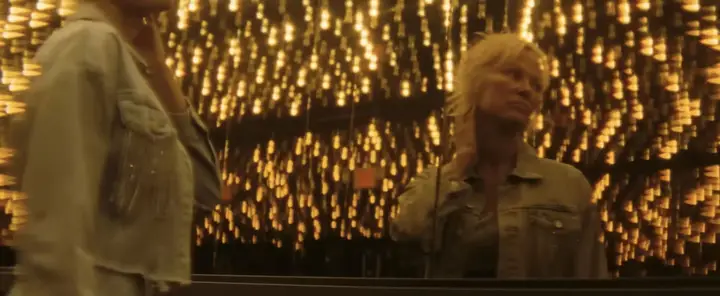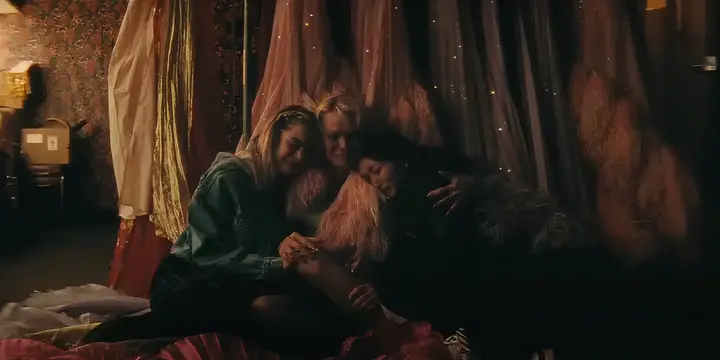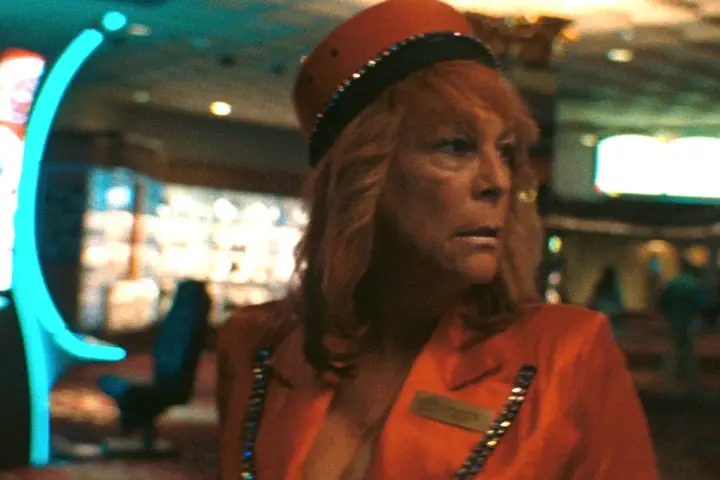In truth, there’s nothing all that new or revelatory about The Last Showgirl. It’s the kind of movie Hollywood loves, especially around awards time. Movies about ageism and the uncaring cynicism of the Hollywood system not set in Hollywood are like PB&J to the Academy. They eat it up.
Yet, what makes Gia Coppola’s The Last Showgirl special is the central performance by Pamela Anderson. In many respects, the Sydney Sweeny of the 90s Anderson was a pop-culture phenomenon that was rarely utilized for her potential and instead too often used for easy sex appeal. It would be easy to extoll how Anderson and Coppola used her experiences to craft the character of Shelly Gardner, an aging showgirl facing the end of a job that’s been the only life she’s ever known.

Except, it would be almost a disservice to dismiss Anderson’s turn as mere life-imitating art. What she brings to Shelly, lived experiences aside, is a fearlessly flawed creation. Shelly is filled with rage, hurt, and an abiding loneliness, and she seems incapable of escaping unless she’s on stage. Coppola takes Kate Gersten’s too-simplistic script and instead uses it as a compass to find fascinating valleys of emotions within Shelly and the other characters within The Last Showgirl.
Characters like Shelly’s best friend, Annette (Jamie Lee Curtis), an alcoholic cocktail waitress who gambles most of her paycheck away. Curtis plays Annette with a boozy aplomb. With her sunbaked tan and day-old make-up, her Annette is a battle-scarred, weary companion, less naive than Shelly but no less scared. The scenes with Curtis and Anderson are among the best in the movie as they are less tragic and more heartening. We see two women incapable of forming new bonds and struggling to maintain the one bond they know and understand: each other.
Coppola, the granddaughter of Francis Ford, displays a talent for mining material for more depth than it realizes it has. She uses Autumn Durald Arkapaw’s camera like a scalpel to peel back the protective shield the characters put up to avoid being too vulnerable. I would have liked it if Arkapaw’s camera had settled down more. At times, it felt like it was trying too hard to craft the verite of the moment.
Subplots like Shelly trying to reconnect with her daughter, played by Bille Lourde, come off as trite and too easy. Other scenes, such as the ones involving Shelly’s fellow dancers, played by Brenda Song and Kiernan Shipka, are too brief and leave us wishing there were more of them and less of the estranged mother-daughter melodrama. Shipka was briefly in last year’s Twisters, and I thought she was more charismatic than the movie’s actual lead. Her brief scenes with Anderson and Song prove me correct. In one instance, she shows up at Shelley’s door looking for a shoulder to cry on; Shelly’s rejection is heartbreaking as Coppola allows us to see the loneliness and pain on Shipka’s expressive face.

For every scene that feels truncated, there are moments when Coppola and Arkapaw sit back and let the camera contemplate the characters—giving us glimpses of the tender sadness within them. The Last Showgirl understands the power of an actor’s visage and how a camera can peer into it and find great truth.
Coppola is unafraid to sit in the quiet moments. She allows scenes where Shipka’s character invites Dave Bautista’s Eddie to a girl’s night to play out with a tense naturalism. Characters use dialogue as a shield, protecting themselves and wounding others to compensate for their pain. In these instances, Coppola shows an eye for character akin to John Cassavetes or Mike Leigh, directors who knew how to work with actors to bring their characters to life in a way that, even if they seemed implausible, they felt real.
One great scene involves Curtis as Annette, in her slinky cocktail uniform, taking the stage and dancing to A Total Eclipse of the Heart. Coppola and her editors Blair McClendon and Cam McLaughlin crosscut this with Anderson practicing her routine, illustrating how the two characters mirror each other. Both drowning in the past and needing the other to stay afloat in the present.
Anderson is so captivating because Shelley refuses to be put into a box. She is caring, loving, and kind but also profoundly selfish, arrogant, and naive. She knows a great deal about French theater and dance; Coppola shows her at home watching footage of French revues and other dancers as she tries to desperately put together something she never thought she needed again: an audition.
The Last Showgirl refuses to paint its characters with a single brushstrokes. Even Bautista’s well-meaning Eddie bristles from time to time. A man who cares for Shelly but is also unsure of how to communicate or even talk to her despite their intimate past.

What Anderson’s experience brings to Shelley is not that she was a sex symbol with the temerity to age, though she was and does bring it to bear, but rather how Anderson lived her life her way: messy, imperfect, but honest. An aspect that makes Shelley so fearless is that she is neither a saint nor a monster. We can’t help but feel for her. Her audition for the new show replacing her act had me hiding my face in my hands, peeking through my fingers.
Coppla and Arkapaw contrast the glittery sheen of Las Vegas with the beauty of age. In a way, this contrast recalls another Coppla and his flawed masterpiece, One From The Heart. The younger Coppola seeks to visually bridge the gap between fantasy and reality. The result is a kind of transcendence of material as she meditates on the gulf between the two disparate poles.
But there are no answers in The Last Showgirl. Merely observations and tiny mercies visited upon characters in desperate need of them.
Images courtesy of Roadside Attractions
Have strong thoughts about this piece you need to share? Or maybe there’s something else on your mind you’re wanting to talk about with fellow Fandomentals? Head on over to our Community server to join in the conversation!

